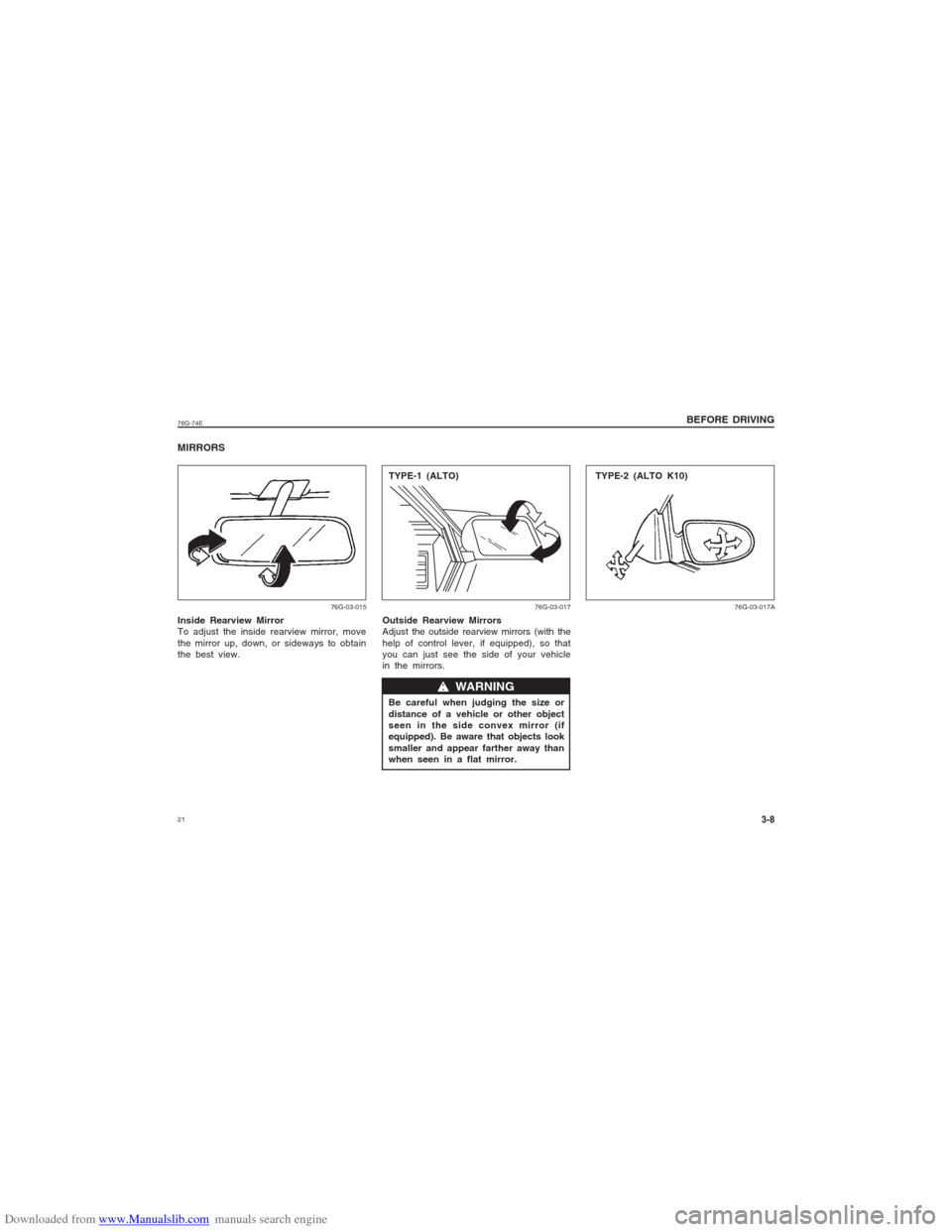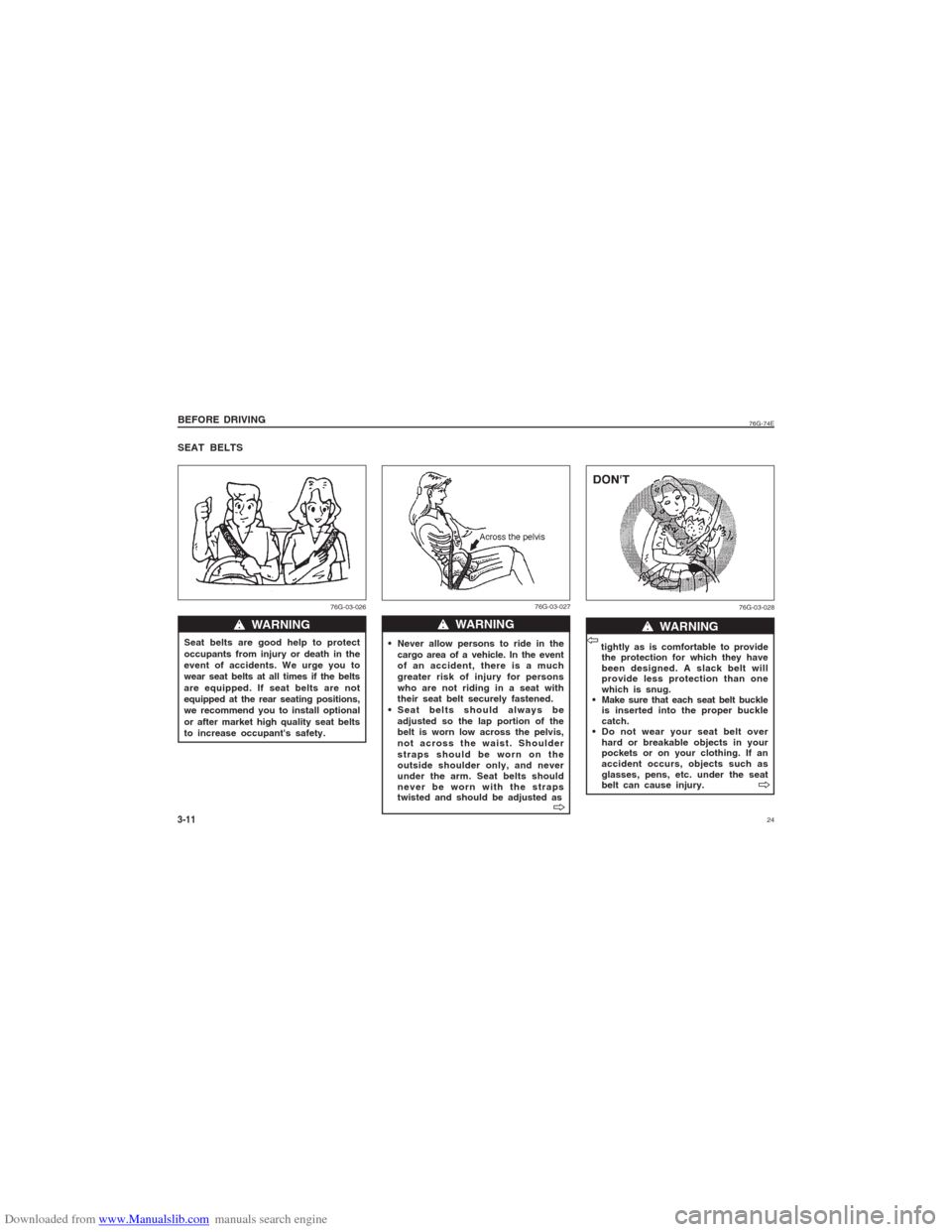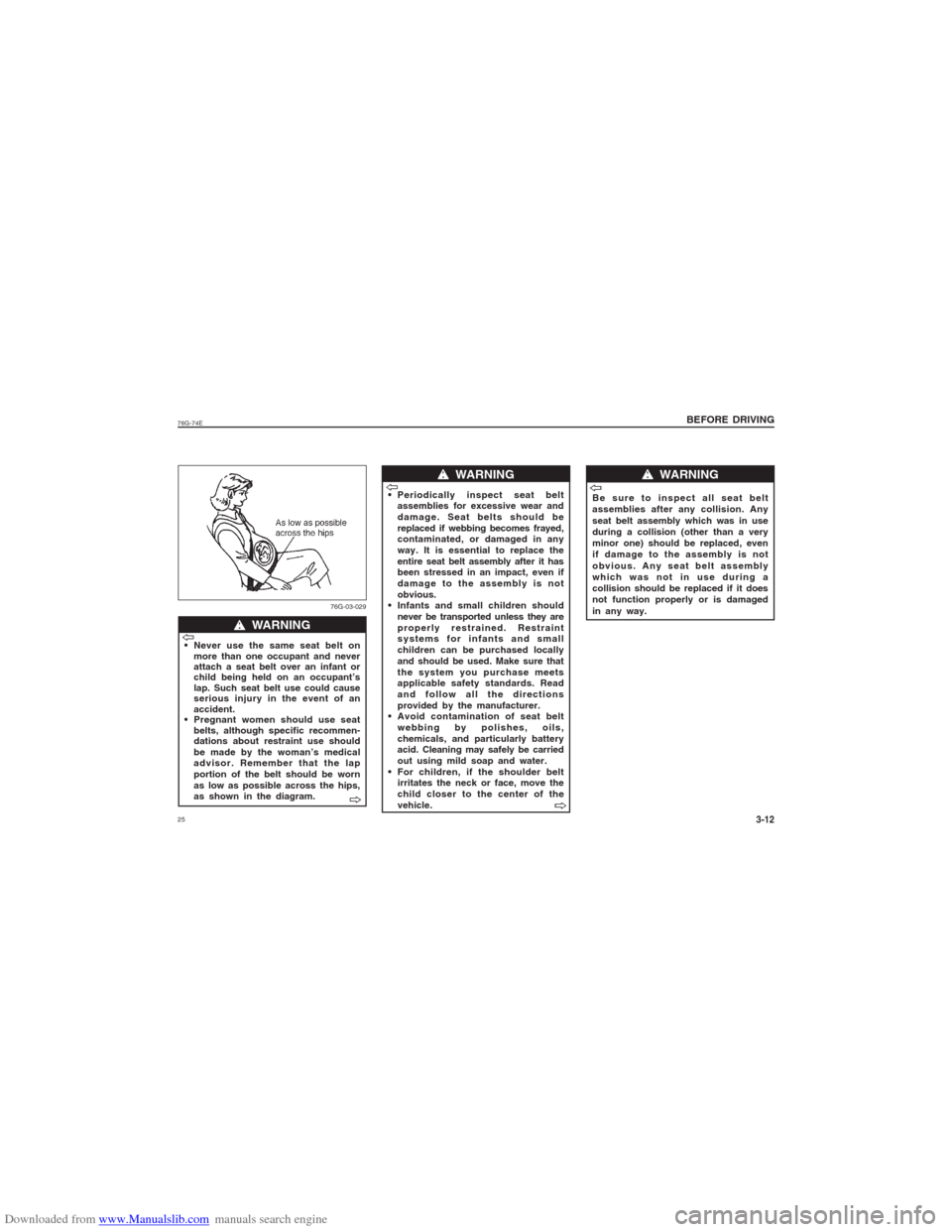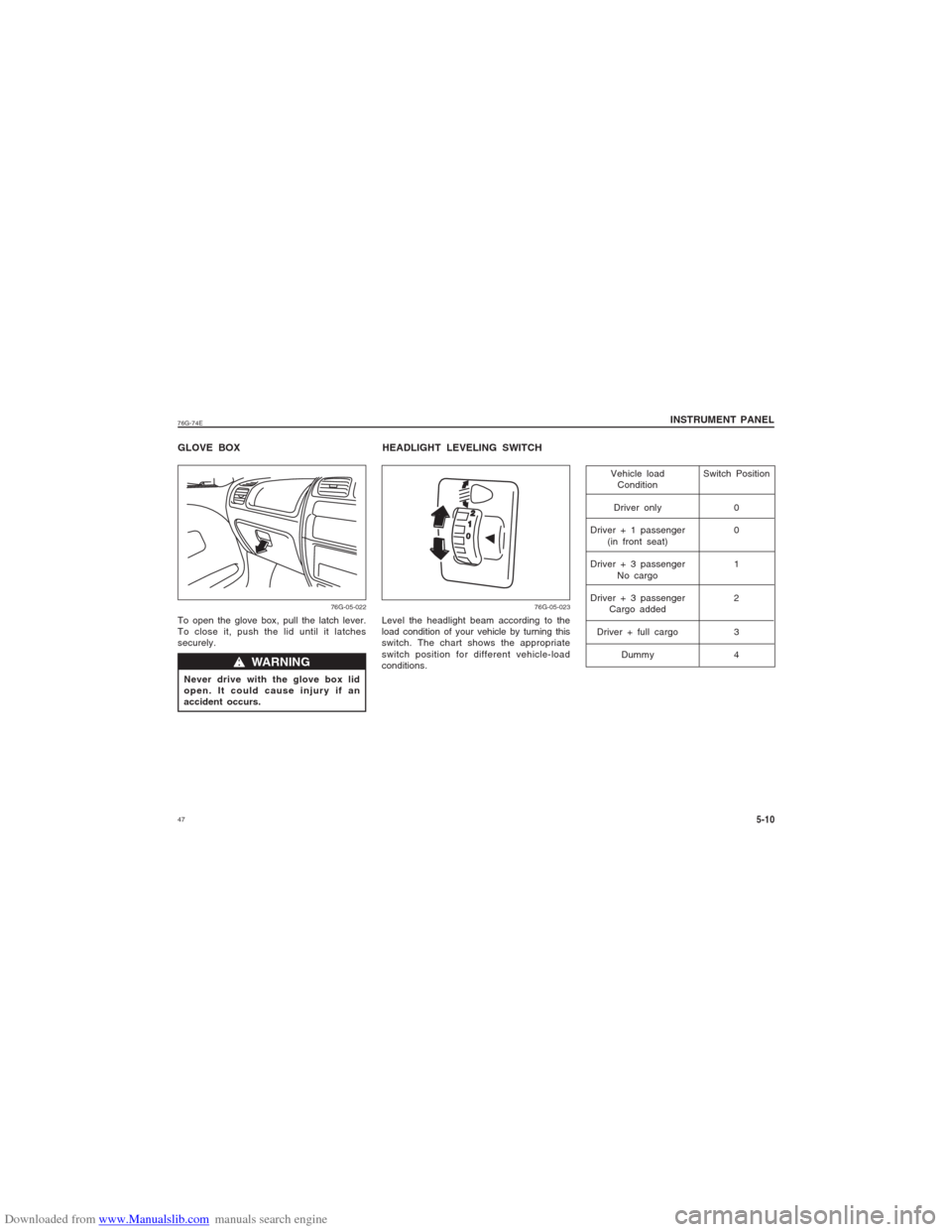2007 SUZUKI ALTO Car ac
[x] Cancel search: Car acPage 20 of 139

Downloaded from www.Manualslib.com manuals search engine 2176G-74E
BEFORE DRIVING
3-8
MIRRORSInside Rearview Mirror
To adjust the inside rearview mirror, move
the mirror up, down, or sideways to obtain
the best view.
76G-03-015
Outside Rearview Mirrors
Adjust the outside rearview mirrors (with the
help of control lever, if equipped), so that
you can just see the side of your vehicle
in the mirrors.
Be careful when judging the size or
distance of a vehicle or other object
seen in the side convex mirror (if
equipped). Be aware that objects look
smaller and appear farther away than
when seen in a flat mirror.
w ww w
w WARNING
76G-03-017
76G-03-017A
TYPE-1 (ALTO)
TYPE-2 (ALTO K10)
Page 23 of 139

Downloaded from www.Manualslib.com manuals search engine 24
76G-74E
BEFORE DRIVING3-11Seat belts are good help to protect
occupants from injury or death in the
event of accidents. We urge you to
wear seat belts at all times if the belts
are equipped. If seat belts are not
equipped at the rear seating positions,
we recommend you to install optional
or after market high quality seat belts
to increase occupant's safety.SEAT BELTS
w ww w
w WARNING
76G-03-026
Never allow persons to ride in the
cargo area of a vehicle. In the event
of an accident, there is a much
greater risk of injury for persons
who are not riding in a seat with
their seat belt securely fastened.
Seat belts should always be
adjusted so the lap portion of the
belt is worn low across the pelvis,
not across the waist. Shoulder
straps should be worn on the
outside shoulder only, and never
under the arm. Seat belts should
never be worn with the straps
twisted and should be adjusted as
w ww w
w WARNING
V VV V
V
76G-03-027
tightly as is comfortable to provide
the protection for which they have
been designed. A slack belt will
provide less protection than one
which is snug.
Make sure that each seat belt buckle
is inserted into the proper buckle
catch.
Do not wear your seat belt over
hard or breakable objects in your
pockets or on your clothing. If an
accident occurs, objects such as
glasses, pens, etc. under the seat
belt can cause injury.
w ww w
w WARNING
V VV V
V
V VV V
V
76G-03-028
Page 24 of 139

Downloaded from www.Manualslib.com manuals search engine 2576G-74E
BEFORE DRIVING
3-12
Never use the same seat belt on
more than one occupant and never
attach a seat belt over an infant or
child being held on an occupant’s
lap. Such seat belt use could cause
serious injury in the event of an
accident.
Pregnant women should use seat
belts, although specific recommen-
dations about restraint use should
be made by the woman’s medical
advisor. Remember that the lap
portion of the belt should be worn
as low as possible across the hips,
as shown in the diagram.
w ww w
w WARNING
V VV V
V
V VV V
V
76G-03-029
Periodically inspect seat belt
assemblies for excessive wear and
damage. Seat belts should be
replaced if webbing becomes frayed,
contaminated, or damaged in any
way. It is essential to replace the
entire seat belt assembly after it has
been stressed in an impact, even if
damage to the assembly is not
obvious.
Infants and small children should
never be transported unless they are
properly restrained. Restraint
systems for infants and small
children can be purchased locally
and should be used. Make sure that
the system you purchase meets
applicable safety standards. Read
and follow all the directions
provided by the manufacturer.
Avoid contamination of seat belt
webbing by polishes, oils,
chemicals, and particularly battery
acid. Cleaning may safely be carried
out using mild soap and water.
For children, if the shoulder belt
irritates the neck or face, move the
child closer to the center of the
vehicle.
w ww w
w WARNING
V VV V
V
V VV V
V
Be sure to inspect all seat belt
assemblies after any collision. Any
seat belt assembly which was in use
during a collision (other than a very
minor one) should be replaced, even
if damage to the assembly is not
obvious. Any seat belt assembly
which was not in use during a
collision should be replaced if it does
not function properly or is damaged
in any way.
w ww w
w WARNING
V VV V
V
Page 40 of 139

Downloaded from www.Manualslib.com manuals search engine 4176G-74EWARNING AND INDICATOR LIGHTSBrake fluid level warning/Parking Brake
Indicator light
This light operates under three different type
of operations :
1) The light comes on briefly when the
ignition switch is turned to the “ON” postion.
2) The light comes on when the parking
brake is engaged with the ignition switch in
the “ON” position.
3) The light comes on when the fluid in the
brake fluid reservoir falls below the
adequate level.
The light should go out after starting the
engine and fully releasing the parking brake,
if the fluid level in the brake fluid resevoir
is adequate.
If the light does not go off or comes on
whilst your driving, it may mean that there
is something wrong with the vehicle's
braking system. If this happens, you should:1) Pull off the road and stop carefully.
Remember that stopping distance may
be longer, you may have to push harder
on the pedal, and the pedal may go
down farther than normal.
2) Test the brakes by carefully starting and
stopping at the side of the road.
3) If you determine that it is safe, drive
carefully at low speed to the nearest
dealer for repairs. or
4) Have the vehicle towed to the nearest
dealer for repairs.
INSTRUMENT PANEL
w ww w
w WARNING
w ww w
w WARNING
5-4
NOTE:
Because the disc brake system is self
adjusting, the fluid level will drop as the
brake pads become worn.
Replenishing the brake fluid reservoir is
considered normal periodic maintenance.
76G-05-005
If any of the following conditions occur,
you should immediately ask your
MARUTI SUZUKI dealer to inspect the
brake system.
If the brake fluid level warning light
does not go out after the engine has
been started and the parking brake
has been fully released.
If the brake fluid level warning light
does not come on when the ignition
switch is turned to the “ON” position
with the parking brake applied.
If the brake fluid level warning light
comes on at any time during vehicle
operation.
Page 46 of 139

Downloaded from www.Manualslib.com manuals search engine 4776G-74E
INSTRUMENT PANEL
5-10
Vehicle load Switch Position
Condition
Driver only 0
Driver + 1 passenger 0
(in front seat)
Driver + 3 passenger 1
No cargo
Driver + 3 passenger 2
Cargo added
Driver + full cargo 3
Dummy 4
Level the headlight beam according to the
load condition of your vehicle by turning this
switch. The chart shows the appropriate
switch position for different vehicle-load
conditions.HEADLIGHT LEVELING SWITCH
76G-05-023
To open the glove box, pull the latch lever.
To close it, push the lid until it latches
securely.
Never drive with the glove box lid
open. It could cause injury if an
accident occurs.
w ww w
w WARNING
76G-05-022
GLOVE BOX
Page 61 of 139

Downloaded from www.Manualslib.com manuals search engine 62
76G-74E
6-5OTHER CONTROLS AND EQUIPMENTThe rear seats of your vehicle can be folded
forward to provide additional luggage space.
To fold the rear seats forward, pull up the
two lock knobs (1 and 2) on top of the
seat simultaneously and fold the seatback
forward. To raise the seatback lift it up and
push it back until it locks into place.When returning a rear seat to the
normal position, make sure that
movement of the seatback is
unobstructed and the seatback is
securely latched.
w ww w
w WARNING
76G-06-011
EXAMPLE
Luggage or other cargo should be
stowed in the luggage compartment
with the rear seat in an upright
position, whenever possible. If you
need to carry cargo in the passenger
compartment with the rear seat back
folded forward, be sure to secure the
cargo or it may be thrown about,
causing injury. Never pile cargo higher
than the seatbacks.
w ww w
w WARNING
SUN VISORThe sun visor(s) can be pulled down to
block glare coming through the wind screen,
or they can be unhooked and turned to the
side to block glare coming through the side
window.
When unhooking and hooking a sun
visor, be sure to handle it by the hard
plastic parts or the sun visor can be
damaged.
CAUTION
76G-06-012
FOLDING REAR SEATS
Page 69 of 139

Downloaded from www.Manualslib.com manuals search engine 70
76G-74E
EXHAUST GAS WARNING
with the engine running, make sure
the air intake lever is set to “FRESH
AIR” and the fan is at high speed.
Avoid operating the vehicle with the
rearend door open. If it is necessary
to operate the vehicle with the
rearend door open, make sure all
the windows are closed and the fan
is at high speed with the air intake
lever set to "FRESH AIR".
To allow proper operation of your
vehicle’s ventilation system, keep
the air inlet grille in front of the
windscreen clear of snow, leaves, or
other obstructions at all times.
Keep the exhaust tailpipe area clear
of snow and other material to help
reduce the buildup of exhaust gases
under the vehicle. This is
particularly important when parked
in blizzard conditions.
Have the exhaust system inspected
periodically for damage and leaks.
Any damage or leaks should be
repaired immediately.
DAILY INSPECTION CHECKLIST
w ww w
w WARNING
7-1
w ww w
w WARNING
Before driving:
1)
Make sure that windows, mirrors, lights,
and reflectors are clean and unobstructed.
2) Check the tyres.
3) Look for fluid and oil leaks.NOTE:
It is normal for water to drip from the air
conditioning system after use.4) Adjust the seat/head restraint.
5) Check the brake pedal and the parking
brake lever.
6) Adjust the mirrors.
7) Make sure that you and passengers
have properly fastened your seat belts.
8) Make sure that all warning lights come
on as the key is turned to the “ON” or
“START” position.
9) Check all gauges.
10) Make sure that the brake fluid level
warning light is off when the parking
brake is released with the engine
running.
OPERATING YOUR VEHICLEAvoid breathing exhaust gases.
Exhaust gases contain carbon
monoxide, a potentially lethal gas that
is colourless and odourless. Since
carbon monoxide is difficult to detect
by itself, be sure to take the following
precautions to help prevent carbon
monoxide from entering your vehicle.
Do not leave the engine running in
garages or other confined areas.
Do not park with the engine running
for a long period of time, even in an
open area. If it is necessary to sit
for a short time in a parked vehicle
V VV V
V
V VV V
V
76G-07-00176G-07-002
Page 73 of 139

Downloaded from www.Manualslib.com manuals search engine 74
76G-74E
7-5OPERATING YOUR VEHICLE
RUNNING-IN
The future performance and reliability
of the engine depends on the care
and restraint exercised during its early
life. It is especially important to
observe the following precautions
during the initial 1000 km of vehicle
operation.
After starting, do not race the
engine. Warm it up gradually.
Avoid prolonged vehicle operation at
a constant speed. Moving parts will
bed in better if you vary your speed.
Do not exceed 100 km/h.
Start off from a stop slowly. Avoid
full throttle starts.
If possible, avoid hard braking,
especially during the first 300 km
of driving.
Do not drive slowly with the
transmission in a high gear.
Drive the vehicle at moderate engine
speeds.
CAUTION
Even without reserve power in the
brake system, you can still stop the
vehicle by pressing the brake pedal
harder than normally required.
However, the stopping distance may
be longer.
On loose surface where the wheels
can easily loose traction (such as
gravel, etc.), the stopping distance
required for your vehicle may be
greater than for a comparable vehicle
with a conventional brake system.
Allow for extra stopping distance
when driving on loose surfaces.
w ww w
w WARNINGw ww w
w WARNING
CATALYTIC CONVERTERThe purpose of the catalytic converter
installed on your vehicle is to convert
exhaust pollutants to harmless water vapour,
carbon dioxide, and nitrogen. Use of leaded
fuel in vehicles equipped with catalytic
converters is prohibited, because lead
deactivates the pollutant-reducing compo-
nents of the catalyst system.
It is very important to keep the engine
properly tuned. Engine misfiring, which can
result from an improperly tuned engine, may
cause overheating of the catalyst. This may
result in permanent heat damage to the
catalyst and other vehicle components.
76G-07-005